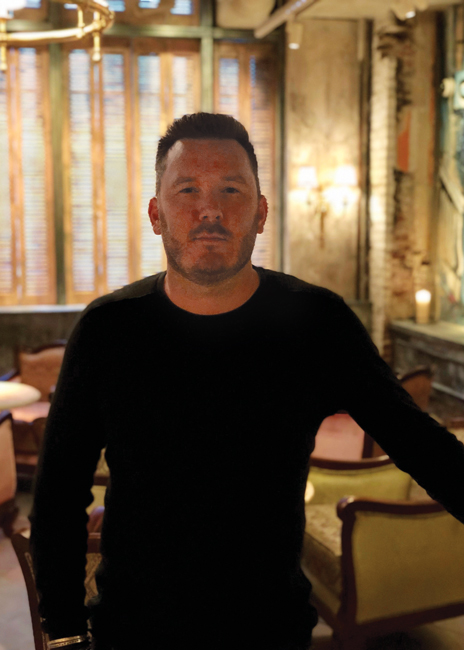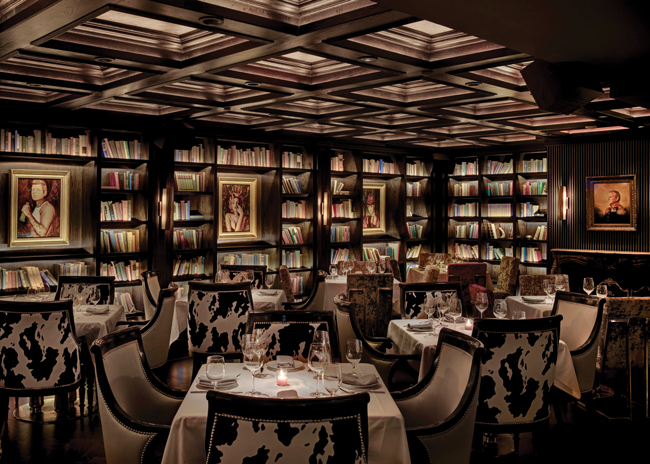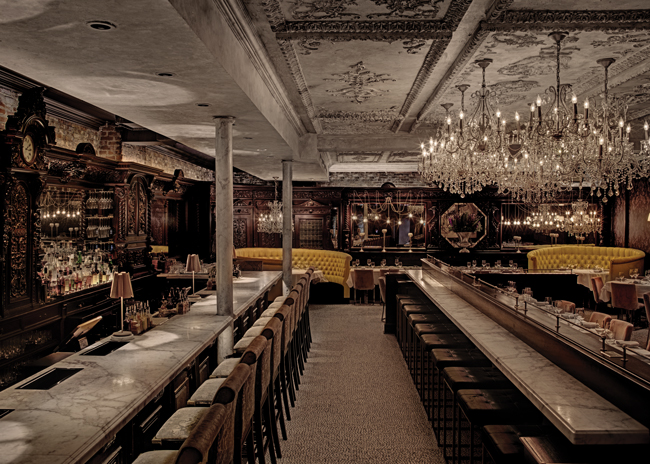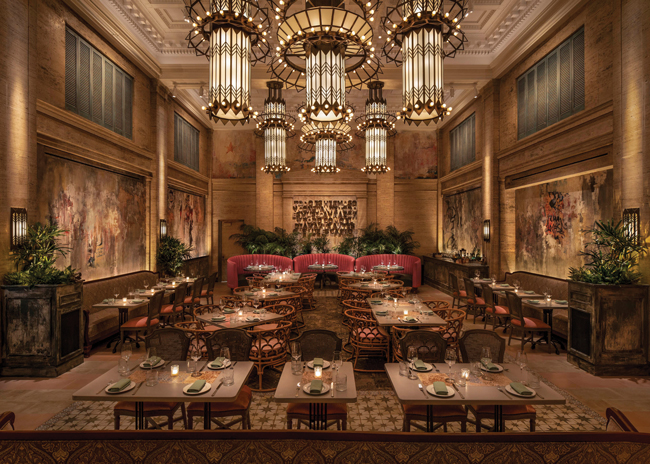 Chris JamisonIn Boston, COJE Management Group is synonymous with dining that offers great food, social-media-friendly drinks, and maximalist designs that together create memorable, immersive dining experiences at their restaurants and bars. CEO Chris Jamison is a founding partner, operator, and design visionary behind the group’s popular restaurants, including Lolita, Yvonne’s, Mariel and Ruka.
Chris JamisonIn Boston, COJE Management Group is synonymous with dining that offers great food, social-media-friendly drinks, and maximalist designs that together create memorable, immersive dining experiences at their restaurants and bars. CEO Chris Jamison is a founding partner, operator, and design visionary behind the group’s popular restaurants, including Lolita, Yvonne’s, Mariel and Ruka.
I understand your background is in real estate, not design. We’d love to know what got you started in restaurant design. And when did you know you were going to be the driver behind COJE projects overall aesthetics?
CJ: The real estate world was a brief stint after college, but it was never a passion of mine. Even then, the design, development and construction of the projects I was involved with were my focus. One of the first things I wanted to be when I grew up was an architect. I remember spending hours laying out homes on graph paper, ideating wild structures, sketching castles…I don’t know. It’s one of my earlier memories about what I wanted to be. Art and design have always moved me, and I suppose this is just an extension of that feeling. Hard to pinpoint a moment — I think what I’m doing now is the confluence of a variety of things that have always captured my imagination.
 Yvonne's in Boston has a library-themed dining area with a secret bookcase that leads to a private event space. Images courtesy of Richard Cadan
Yvonne's in Boston has a library-themed dining area with a secret bookcase that leads to a private event space. Images courtesy of Richard Cadan
COJE restaurants have a maximalist flair. Where do you find your inspiration?
CJ: I’ve been fortunate enough to travel extensively and am always inspired by what I see around the world. We have made a point to take our team on research trips to gain a better understanding of the areas that inspire our various restaurants. For example, when we were embarking on Mariel, our old-world Cuban-inspired restaurant, my team and I traveled to Cuba together. We took the time to learn and imagine what it means to be Cuban — what it looks, smells and tastes like. The restaurant offers a glimpse into our interpretation of Cuba and its enchanting culture, how they’ve evolved and adapted around the world, and adopted the influences brought to its people from faraway lands such as Asia and Africa. I take inspiration from everywhere we go and then do my best to make it our own while respecting its origin.
How do you work with your team when it comes to design and execution? Do you give them broad strokes and let them fill in the details or do you dig deep into the small touches yourself?
CJ: I am a terrible micromanager when it comes to design. My team will certainly say the same thing. I firmly believe the details make all the difference, and sometimes I get carried away on what detail is too small to worry about. I know it’s cost us a fortune over the years!
 The design at Yvonne’s is glamorous and playful. To start, I generally try and ideate the broad strokes, some key reference images, some narrative about what we want a space to become, and team members come back with a lot of color and extensions around those ideas. The best part is seeing the interpretation of an idea through others’ eyes, and some of those interpretations have yielded the best results for us. The “THAT’S IT!” moments are always so wonderful, and this is where our collaborative process really excels. I have a tremendous amount of respect for professional designers who can put everything together cohesively, because it’s incredibly difficult. The number of decision points that go in to creating a 10,000-square-foot restaurant is mind-blowing. Generally, the team will come up with some great options for everything from light fixtures to fabrics, to chair profiles, wall finishes, wood grains, floor stains, you name it. At the end of the day, I’m generally the one that makes go/no-go decisions but with a whole lot of input from others.
The design at Yvonne’s is glamorous and playful. To start, I generally try and ideate the broad strokes, some key reference images, some narrative about what we want a space to become, and team members come back with a lot of color and extensions around those ideas. The best part is seeing the interpretation of an idea through others’ eyes, and some of those interpretations have yielded the best results for us. The “THAT’S IT!” moments are always so wonderful, and this is where our collaborative process really excels. I have a tremendous amount of respect for professional designers who can put everything together cohesively, because it’s incredibly difficult. The number of decision points that go in to creating a 10,000-square-foot restaurant is mind-blowing. Generally, the team will come up with some great options for everything from light fixtures to fabrics, to chair profiles, wall finishes, wood grains, floor stains, you name it. At the end of the day, I’m generally the one that makes go/no-go decisions but with a whole lot of input from others.
You have been utilizing AI to help bring your visions to visual life. Can you tell us how you’ve been utilizing these new tools and how you think they may impact the way entrepreneurs and visionary leaders work?
CJ: I think the advent of text-to-image AI is one of the most seminal moments in the history of design — and certainly spatial design. The normal process goes something like this: Operator has an idea for a restaurant, operator hires architect/designer, operator tells designer what he’s thinking, designer takes notes. designer takes a few weeks, comes back with some mood boards and reference images. After some dialogue, perhaps a renderer is engaged to mockup some of those textures and elements in a CAD or REVIT file that the architect built. A few more weeks of back and forth, and perhaps you see something that looks reasonably like what the operator imagined in his head. But most likely not really. You’re tens of thousands of dollars and many weeks into a process before you have anything on paper you can show a potential partner, landlord, investor or even your team.
Now let’s imagine the operator’s first call is to a prompt engineer, a graphic designer with experience in, say, Midjourney, Topaz, or Photoshop. Working closely with the graphic designer, the operator will have an incredibly detailed, fully rendered visual that — most likely — not only captures his vision for a space but incorporates and expands on ideas that he couldn’t even fathom to describe. It’s like unlocking parts of your brain, layering ideas in to your own, that you couldn’t possibly have even thought to tell the designer or architect about. Now you take THAT imagery, and you begin to work with an architect to put plans to paper. You send it to a millwork shop who can see exactly what you’re asking them to build in 3-D, not a 2-D sketch by the architect of what that chair should look like. The opportunities for unlocking creativity are endless, and we are so excited to work within this new medium.
 For Mariel, COJE Management's Cuban-inspired restaurant, their team took a trip to Cuba to find the right inspirational notes for both the space and the menu.
For Mariel, COJE Management's Cuban-inspired restaurant, their team took a trip to Cuba to find the right inspirational notes for both the space and the menu.
Have you utilized 3-D/VR to conceptualize spaces? Do you find it beneficial if so?
CJ: For me, it’s critical. There are certain design decisions that happen much later in the process than they should because I need to see how a space feels before committing to a finish, a piece of furniture, a work of art. Elevations, scale, orientation of architectural elements — all of that is so hard to perfect in 2-D. I really need to see it in 3-D.
I understand COJE’s next project is the first to work with an outside design firm. How has that process been for you so far?
CJ: It hasn’t been easy, and it’s not something I anticipate we will do again. Giving a large firm the wheel to drive a design based on a preliminary vision is just so difficult. I understand the appeal of owners who want a well-designed product but aren’t too particular about the nuances, but we aren’t that owner. We’re going to continue to do what’s worked so far and seek to find efficiencies and improvements through some of the processes I’ve outlined above.
What advice would you give to other restaurant entrepreneurs who are looking to scale their operations? Or is there a key consideration you wish you knew before that would have been helpful to a serial restaurant developer like yourself?
CJ: Don’t be like us, ha-ha! The way we design restaurants is time consuming and expensive, but it’s built us into one of Boston’s largest restaurant groups in a little over 10 years — and I wouldn’t have it any other way. If you don’t have the vision and passion, finding a trusted design and construction partner who gets your vibe is the way to go, because at least the scale is then in the relationship. +
